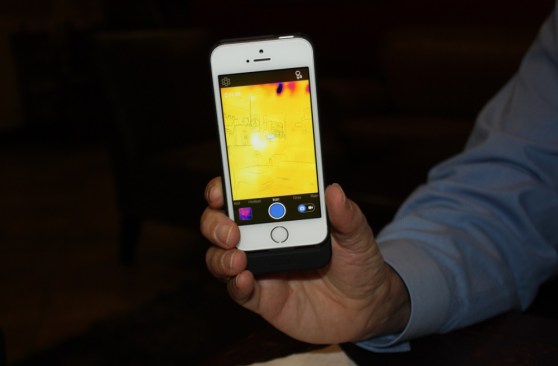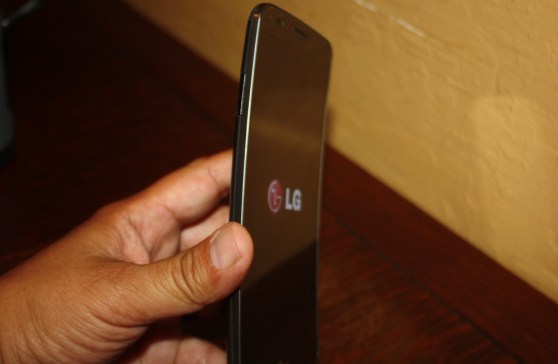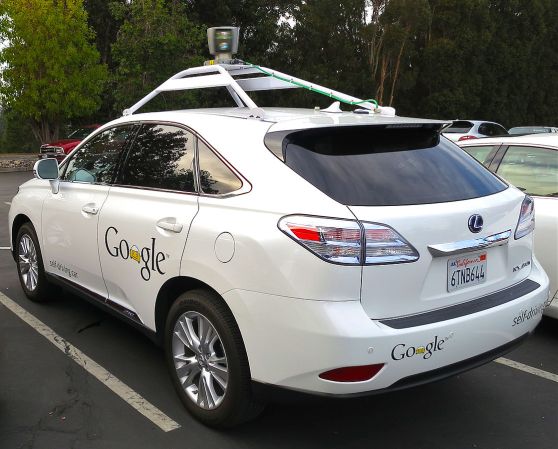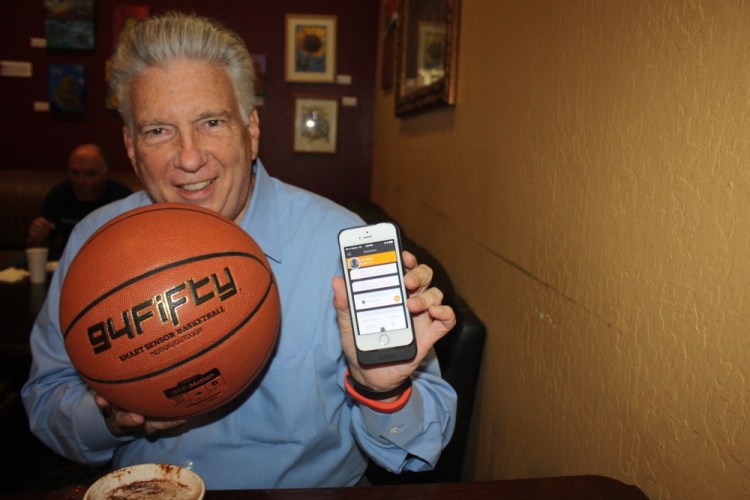
Above: Jim Barry shows off a FLIR app
Barry: This company is a commercial company. I think this is their first venture into consumer products. The neat thing about it, I was in a TV station with a guy, and he says, “Oh, you could see ghosts with that!” I don’t know about it myself, but they have an app developer’s kit out. The applications of this are going to be mind-boggling once people figure out what to do with it.
VB: So it attaches a new camera onto your camera?
Barry: I guess it does. This case is the camera. It’s a two-part case. Again, it’s the kind of thing that has the potential for people — like, the one guy said you could see ghosts with it. Another guy I showed it to likes to go hunting. Apparently it’s not legal to use this hunting at night, because I don’t think the deer can see that way.
VB: It would make it too easy.
Barry: Yeah. This isn’t so much an Internet of Things application. The basketball is. We have a couple of home devices in that area, which also fit into the same category as that bed from several years ago. This is the WeMo, from Belkin, which is basically an outlet that then uses Wi-Fi and an app. You can use that to smarten up the outlet and use your phone to turn on or off whatever you’ve plugged in. It steps into the whole electronic house, the controlled house, the networked house, whatever you want to call it.
This is from a company called ThinkEco. You plug your air conditioner into this, and again what it does is it smartens it up. Any dumb window air conditioner can be controlled from your phone using the app and this, once it’s connected to Wi-Fi.
Consumers hear about this all the time — the connected home, the electronic home. That’s going to be a big deal at CES this year. These are ways to renovate your home and get stuff started in that direction. Lowe’s has one, their Iris system, which is the same idea. I think it’s something like $179 for the basic system. It’s a controller, a couple of window sensors, and a motion sensor. Then you can add to that with things like water-level sensors for the basement. It’s great for people who go away for long trips or who have a vacation home. You’re able to convert an older house into an electronic house.
VB: On a corporate level, one thing I find interesting is this free-for-all to get chips into all these devices and then design and build the devices themselves. Intel is going in that direction – not only doing chips for the Internet of Things, but also making the things that use those chips.
Barry: You might ask, “Why would they want to get into the device business?” The margins are low to begin with and only going lower, with few exceptions. Apple’s been able to maintain their market with good margins. But televisions are a good example, UltraHD televisions.
This market, the wireless Bluetooth speakers, is very quickly becoming an analog to the docking station market seven or eight years ago, right after the iPhone. Suddenly there were lots of them at the show. You’d see that whole iLounge area. But this isn’t just for iPhones now. It’s any Bluetooth device. Bluetooth has gotten better. It’s very simple now. Just google for “wireless Bluetooth speakers,” and you’ll see scores of them for $29 and up. Waterproof ones, everything. These are from a company called Scosche.
There was another very cool one you may have seen called the SpeeCup. The idea there is, you buy a new car now, and you get Bluetooth built in. You get in, connect your phone, you’re in business. The SpeeCup is designed for people who don’t have Bluetooth in their car, but do have cupholders. It looks like a tall cup of coffee. It has gesture and touch control. More than anything, it’s a remarkable statement of industrial design and ingenuity. “Everyone has cupholders. Let’s design a speaker that fits in there.”
These are more Internet of Everything, these types of devices. You mentioned clothing. Lots of clothing. Everything has sensors in it. It’s what used to be known as embedded technology. That’s now the Internet of Everything. More people will be talking about it. I’m sure there are big battles going on for control of that market and over the types of sensors.
I have some new tablets as well. The LG Flex, have you seen this one? This is the one that does bend. It comes with the bend built in. It’s a six-inch screen.

Above: The intentionally bent LG smartphone
VB: That’s nice. An intentional bend.
Barry: Again, the bend there is twofold. It’s supposed to give better acoustics when you’re holding it up and talking. It’s also a statement about the OLED technology, which is flexible. It’s getting into more and more big-screen TVs. Until now it’s only been in small screens, and it hasn’t been flexed, although we’ve seen a lot at the show. Sony, a couple of years ago, had the wristband screen. We’re going to see more of those.
UltraHD television is another big thing that’s happening. Prices are already down remarkably low for a new technology. Last year the sales were 75,000 or 80,000, which isn’t a lot. This year it’s supposed to be 800,000, ten times as many, and next year more than 3.5 million. That’s a pretty good ramp up. Part of that’s the price coming down. I’ve seen them for $1,500.
This is an industry that just eats its young, the television business. It’s wonderful for consumers, but look at the roster of TV manufacturers that have come and gone. Part of it is this fierce price competition. Part of it is the cycle of purchase. So many people bought TVs from 2000 to 2010 as the transition from analog to digital and from CRTs to flat panels happened.
On the software side, not a lot yet, but two things strike me about that. One is the insurgence in delivery. Netflix in particular is already producing a whole bunch of original content in 4K for UHD. It’s going to take a while for the networks. But there’s as much innovation and change happening in the delivery. You have the announcement by HBO that they’re basically going the Netflix route, the streaming route. There’s going to be a lot in the next year.
The other good thing is, if you buy one of these, it’ll up-convert what you’re watching already. That’s good news for people who say, “Why would I buy one now when there’s nothing to watch on it?” There’s plenty to watch. All the regular HD you watch will be even better. Some of those will be curved also. Sony has those, Samsung, LG.
VB: As far as brand new categories that weren’t around last year, do you see anything?
Barry: A couple of things. A lot of these kind of percolate in the background for a while and then grow. We’re going to see two or three times as much in the 3-D printing area. As a consumer product, it may be a little ways away still, even though there’s all this cool stuff people have been making – everything from candy to all kinds of other stuff.
There’s digital health and digital fitness. Fitness is more this kind of stuff, fitbands and stuff. Health is more the blood pressure monitors and so on. You’re also going to see this Eureka Park area growing more than four times now, this innovation incubator. There’s a university part to that now that’s bringing in people from university-based innovation hubs. You’re going to see more of that.
The whole automobile thing, the car show. We joked that we went to CES and an auto show broke out. That’s been true for the last several years. We had nine of the top automakers there last year. We had the chairman of Audi last year calling the automobile the consumer electronics platform of the 21st century.
Sooner than later, my feeling is that we’ll see self-driving cars a lot more. We saw a bit more last year. You guys out here, with the Google stuff, see more of than we do back east. But you just look at the ads on TV – cars that will brake if you get too close, sensors that tell you if you’re drifting into another lane.
 VB: I’m finding that with the boom times in Silicon Valley, the freeways are more crowded and the drivers are more distracted. I’m looking forward to more self-driving cars.
VB: I’m finding that with the boom times in Silicon Valley, the freeways are more crowded and the drivers are more distracted. I’m looking forward to more self-driving cars.
Barry: Remember, I’m from Boston. The roads there are the worst, at all hours of the day.
We had this conference in Phoenix a couple of weeks ago, Innovate, which is kind of the successor to the old fall conference, the industry forum that CEA has had for years. Nolan Bushnell spoke there. He was great. He had some stuff about self-driving cars, about the economics as compared to investing in public transportation. All I can remember was a difference of like $0.35 for self-driving vehicles versus $2.79 or something like that for public transportation. Which sounds like an astonishing number. Once it makes economic sense, and the technology is getting closer all the time, he was talking about self-driving Ubers and all that kind of stuff. It’ll be pretty interesting.
One of the things I told people for a long time, if you can imagine it, it’s probably possible. With the exception of the beam-me-up-Scotty stuff. That, I think, is still a ways away. I wouldn’t want to be the first guy to try that, either.
VB: Does any of this stuff worry you, or does it all make you happier, this internet of Everything?

